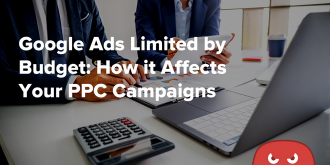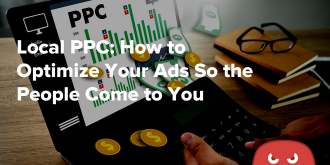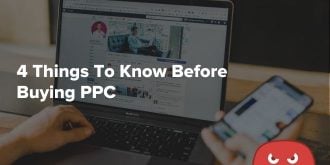Quick Links
Billboards were a revolution in advertising, used as far back as the 1830s and growing immensely since then.
About 160 years later, on October 27th, 1994, AT&T revolutionized the concept of billboard advertising. They purchased a rectangular piece of ad space on HotWired.com, effectively inventing the display ad and bringing the billboard concept to the internet.
Internet ads have evolved significantly since then — accounting for the most ad spend share in 2021 at $238 billion.
So you have a lot of competition both in getting yours in front of your customers and getting them to click.
This article will discuss the types of display ads and what makes a good one, then go over a few display ad examples to give you inspiration.
What Are Display Ads?
Display ads, also known as banner ads, are those little ads that you see appear in various spaces on websites, such as at the top or on the sides.
The goal of these ads is to grab a reader’s attention and drive them to a landing page or product page.
This form of paid media has four basic elements:
- Visual/creative: A photograph, gif, image, or other visual design of some sort that captures the reader’s attention.
- Headline: A large line of text that works together with the visual and creative to grab the reader’s attention.
- Copy: Additional text supporting the headline and pulling the reader towards the CTA button.
- Call to action (CTA): A button or link that urges the user to click. This takes the user to a landing page, website, or in-app destination.
Additionally, your brand logo should be somewhere in the banner ad, so the reader knows who’s running the ad.
These days, over half of all internet traffic is mobile traffic. Therefore, the latest significant evolution in banner advertising is the importance of mobile optimization.
Optimizing for mobile will ensure you can target smartphone and tablet users without slowing down their devices or creating too invasive of an ad.
Search ads vs. display ads
Search ads use a pull approach, meaning they appear in front of users already looking for something relevant to what you offer. The goal is to “pull” them to the next page. They’re the foundation of the advertising side of search engine marketing.
On the other hand, display ads are more of a “push.” You can “push” them out to customers who are, for example, reading a blog that’s in your niche or adjacent to it.
They’re not looking for what you offer, but you’re putting your brand in front of them.
As you can see, each ad type serves its role. Usually, combining search and display ads offers the most ROI when running pay-per-click campaigns.
Benefits of display ads
Display ads may look simple, but they offer plenty of benefits when you use them correctly.
Here are some reasons display ads could have a place in your marketing and advertising arsenal:
- Visually appealing
- Offer numerous targeting options
- Work well as part of a larger strategy
- Wide reach through the Google Display Network
- Simple to change, test, and track
- Increases click-throughs, conversions, and customer retention
- Can “steal” customers from the competition with good retargeting
Types of Display Ads
Display ads come in many shapes and sizes, depending on your targeting criteria and ad format. You can mix, match, and test with ease until you find something that converts well.
Targeting
Before you decide on ad formats, you want to define your display ad campaign’s target audience.
Here are some audience targeting factors you can customize your banner ads around:
- Demographics: Target based on general customer information, such as age, gender, and income level.
- Contextual: Reach users based on the theme of certain keywords, your website, or the topic of your ad.
- Search activity: Target audiences based on things they’ve searched for on Google.
- Geographic: Target based on the customer’s location, such as city or state.
- Retargeting: Retarget previous visitors or users based on actions they took previously, such as visiting certain pages on your website.
Format
After you understand the audience you’re targeting, you need to determine what ad format you want to use.
The format you choose may partially depend on your audience, but it’s also worth testing several formats to see which works best.
Here are some common display ad formats:
- Static: A traditional ad with an unmoving image or background, text, and a CTA.
- Animated: A low-quality video or animation, usually a gif or WebM file. Text and CTA are generally the same as a static ad.
- Interactive: Lets users take action with the ad, such as moving an object on the ad around. Could boost interaction and click-throughs.
- Floating: A pop-up ad that stays on screen, even if the user scrolls around the page.
- Expanding: An ad that grows in size when a user clicks or simply moves their cursor over the ad.
- Video: Instead of a gif, which simply repeats and has framerate and other limitations, the entire ad is a video.
Five Traits of a Great Display Ad
Display ads can often seem short and simple, which is why people go through an average of 1,700 display ads per month.
But the average consumer generally only notices and sees about half of those 1,700.
You’re not just up against steep competition — but “ad fatigue” as well. People are so used to the concept of ads that their eyes tend to gloss right over them.
So make sure you nail these five traits of a great display ad to maximize your ROI.
1. The right audience targeting
First and foremost, your ad needs to connect with your audience. To do this, you’ll need to get your audience targeting right.
That means you have to do some market research and figure out who your target audience is. From there, you can choose the right targeting options on the display ads platform you’re using.
(Of course, the easiest way to target the right audience is to retarget a “hot audience,” someone who has already engaged with your brand.)
2. An optimized and persuasive landing page
Ads don’t operate in a vacuum. If your landing page isn’t any good, even the world’s greatest banner ad will end up being a money-suck.
Creating your landing page before your banner ads is often a better idea. Once you have an optimized and persuasive landing page, you can visualize a customer’s journey through this funnel better.
As a result, it’s much easier to come up with banner ad ideas. They’ll be far more congruent and persuasive.
3. Appealing visuals
The visuals might be the most important visible piece of the ad because it catches the reader’s attention.
In some cases, that means using animated ads. The movement could be more likely to catch the eye of any website visitor.
However, with good targeting, usage of color and white space, a tasteful visual, and a short, punchy headline, you can grab peoples’ attention even with a static image.
Regardless of format, spend time designing the ad to make sure it is clean, clear, eye-catching, and on-brand.
4. Clear, simple headline and copy
Banner ads don’t offer a whole lot of room for text. You can only cram in a few words of copy as well to avoid crowding the ad. You need to justify every word of copy and make sure it carries the reader to the CTA.
But your headline has to be powerful enough to get a distracted reader’s attention in only a few words and get the reader to read the copy.
So even if the headline’s only a few words, it might take multiple tries to get it right. Again, you might have to write and rewrite your copy several times.
Look at the examples below, or use our headline generator for inspiration.
Fortunately, you can quickly test multiple versions of the same ad relatively fast (just look at the click-through and conversion rates).
5. Clear CTA
Finally, you need a compelling call-to-action to seal the deal on each click.
This should be congruent with the rest of your copy. For example, if you’re an auto insurance company attempting to get potential customers to sign up for quotes, “Get Your Quote” will usually work better than “Learn More.”
Your CTA has even less room than the headline and may involve visual elements, so lots of testing is necessary here.
Four Excellent Examples of Display Ads
So you know the benefits of display ads and the basics of making one that works.
Now, let’s look at some excellent examples of display ads to give you some inspiration.
1. The HOTH
Here, we have a display ad from yours truly.
As you can see, this ad immediately sticks out through the use of color — which happen to be The HOTH’s brand colors — and the brand mascot.
The headline jumps out as well. It’s large, contrasts well with the background, and provides an immediate benefit in the form of a free call. Plus, the copy following it “value stacks” by attaching a dollar value to the free benefit before adding some CTA copy.
Of course, The HOTH’s brand name is right in there, too.
Now, this ad format allows for some extra copy at the bottom. The copy digs into a pain point — not ranking quickly enough — then once again offers the free call as the solution.
Overall, this ad draws readers in with the visuals, then packs a lot of punch in just a few words of copy.
It could work especially well on users who visited The HOTH’s web pages relevant to its SEO services or SEO-related blog posts but didn’t take action.
In this size, you’d likely find it in the middle of a web page rather than on the side or at the top, but we use the responsive ad format, so it looks good on any device and in any content area.
2. Square
Square chooses simplicity here by going with white text on a black background. This sticks out well, grabbing the reader’s attention. They use space well, leaving enough so the ad doesn’t look busy without sacrificing the information they want to convey.
Speaking of simplicity and copy, the headline stands out more than most other text elements thanks to its size.
Because of this, Square goes with a no-frills, benefit-driven headline. This minimizes distractions and maximizes the focus on a compelling offer for small business owners.
This Square ad looks like it would go right at the top of a web page, given its horizontal rectangular shape.
3. FreshDirect
FreshDirect is an online grocery delivery service.
This ad is clearly a retargeting ad since there’s no copy to explain what FreshDirect actually does — they’re an online grocery delivery service. We can assume this ad is targeting people who know of the brand and have visited their site. It is propelling them to take action.
If that’s the case, this ad can work well, despite the lack of any real headline or copy. An introductory discount is a fantastic idea for a retargeting banner ad, and all FreshDirect really needs to include is the amount of the discount.
The CTA button copy works well, too. It urges the reader to take action with the code immediately.
The design is also pretty good. There are plenty of objects and copy on the display ad, but it still doesn’t appear “busy.”
Like Square, this FreshDirect ad would go at the top of a web page instead of the side.
4. EmblemHealth
Here, we have a floating display ad that pops up on dictionary.com.
This ad is very straightforward in terms of copy. It places the company’s logo and slogan at the top right, so the reader knows who it is without making the brand the focus of the ad.
The ad uses a short but engaging phrase in its headline — “Get health coverage” to urge the reader forward through the copy.
Below that, it offers a benefit before including a CTA button that contrasts well with the background color of the ad. The CTA button copy once again uses a phrase that is clear, specific, and urges action.
Use These Display Ad Examples to Inspire Your Own
Display ads are often simple to make and set up and can reach a large yet targeted audience on sites they love to visit.
However, many of your competitors are probably already investing in display ads — so you’ll have to tweak and test your individual display ads and overall campaigns to maximize ROI.
Now, the other side of a comprehensive PPC strategy is search ads. Combining search and display can boost brand awareness and put yourself at the top of the search results when customers look for your products and services later.
The HOTH can handle the entire PPC operation for you. We’ll generate a healthy stream of leads for you, while you focus on what you do best. Reach out to us today to learn more about how we can help.


















